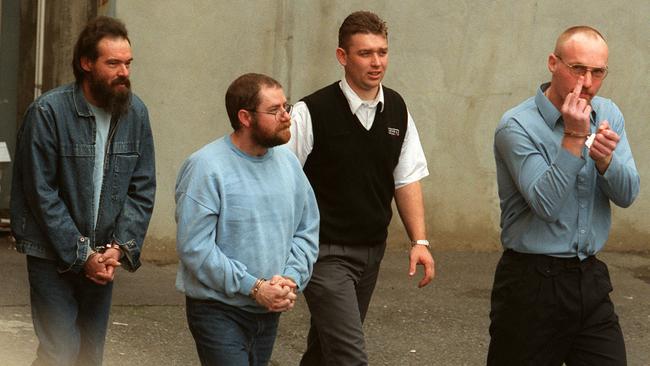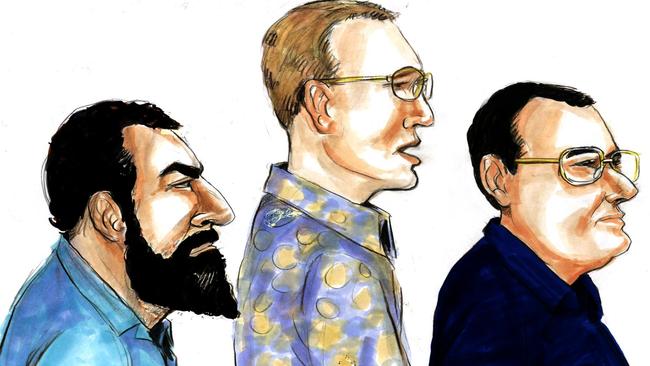Explained – Mark Ray Haydon’s role in covering up the 1990s ‘bodies in the barrels’ serial killing murder spree
On May 21, this man will be released from jail having served a 25-year term. But what part did he play in the serial killing spree that made SA a place of global true-crime myth?

Police & Courts
Don't miss out on the headlines from Police & Courts. Followed categories will be added to My News.
It is a case that lives in infamy – one that, with the passage of time and despite the rise of the internet, is more beset with rumour, myth and misremembering than most.
The 1990s South Australian serial killing spree known as “the bodies in the barrels murders” is back in the news this week, owing to the imminent release of one of the men involved.
Mark Ray Haydon did not take any lives, but played a key part in hiding the macabre mass execution from law enforcement and the public, exacerbating the pain of the victims’ families.
On May 21, he will have served his full 25-year prison term – including his non-parole period – meaning he will be released unless the government can convince the courts to intervene.
WHAT WERE THE “BODIES IN THE BARRELS MURDERS”?

Between August 1992 and May 1999, three men – John Justin Bunting, Robert Joe Wagner and James Spyridon Vlassakis – committed a series of murders.
Bunting was convicted of having committed 11 murders, while Wagner was found to have committed 10 and Vlassakis four.
The murders became notorious not only due to their sheer number, but also the cruelty involved in their commission.
Bunting, a former abattoir who bragged that slaughtering animals was “what he enjoyed most”, served as the group’s ringleader.
During the spree, he claimed to have been ordering and orchestrating the murders of those he believed to be homosexuals, pedophiles or simply “weak” – calling them “dirties”.
Despite that justification, the Supreme Court would subsequently find Bunting was motivated by greed as much as anything else, stealing his victims’ pension payments after their deaths.
It found that, by 1999, he was “in the business of killing for pleasure”.
Another reason for the crimes’ ongoing infamy was their incestuous nature, in that most of the victims were members of the trio’s social circles or even families.
Vlassakis, for example, helped torture and kill his own half-brother, Troy Youde, as well as his stepbrother David Johnson – at the time, he worshipped the “charismatic” Bunting.
Atop all that, the “bodies in the barrels” crimes were unimaginably grotesque.
As the name implies, the bodies of some victims were stored in plastic drums – first beneath the backyard of a northern suburbs home, and then in a disused bank vault at Snowtown.
Wagner, meanwhile, fried some of the flesh of one of the victims for consumption.
He also helped Bunting make audio recordings of their terrified victims that would be played over the phone to convince their families they were still alive.
The transient involvement of Snowtown, 140km from Adelaide, in the crimes lent the small community undeserved and unwanted international attention.
Though only one murder was committed in the town, the barrels were found there by police – leading to international media wrongly calling the crimes “the Snowtown murders”.
This unfair labelling – perpetuated by a movie dramatising the murders – went on to influence the world’s perspective of South Australia for a time.
Our state was wrongly declared “the serial killer capital of the world” and even referenced by the TV show Dexter, despite that claim being demonstrably wrong based on crime statistics.
HOW WAS MARK RAY HAYDON INVOLVED?

When Bunting, Wagner and Vlassakis were arrested on May 21, 1999, so too was Haydon – but the public did not know that.
Now 65, Haydon’s identity was guarded by one of what would become more than 220 suppression orders and publication gags slapped upon the quartet’s case.
Some of those orders remain in force to this day – most of them relating to Vlassakis who, in 2001, pleaded guilty to four murders and gave evidence at trial against his co-offenders.
The court would later hear Haydon was an associate of Bunting and had co-signed the lease on the Snowtown bank where the barrels were found.
Haydon’s wife, Elizabeth, was one of the victims – he was charged with her murder, and with that of Mr Youde.
Prosecutors alleged Haydon had laughed when Bunting lifted the lid of a large barrel to show him the dismembered remains of his wife, including her severed hands.
Though jurors found Bunting and Wagner guilty after the longest and most expensive trial in SA history – costing taxpayers more than $1.1 million – they were deadlocked on Haydon.
They could not reach a verdict, and prosecutors opted not to seek a retrial after Haydon agreed to plead guilty to having assisted in the murders of Elizabeth and Mr Youde.
Vlassakis’ co-operation earned him a comparatively-merciful 26-year non-parole period, while Bunting and Wagner were jailed for 11 and 10 consecutive life terms respectively.
The court declined to set non-parole periods for either of them – to date, they remain the only men in the SA prison system who have been jailed without the possibility of parole.
Given his crime was covering up two murders, not committing them, Haydon’s penalty was different to those of his co-conspirators.
Haydon was jailed for 25 years, with an 18-year non-parole period.
As of May 21 this year, he will have served that full sentence behind bars.
WHAT HAPPENS TO MARK RAY HAYDON NOW?

Under SA law, an offender who serves their non-parole period is entitled to be considered for release into the community, under supervision until their full sentence expires.
In 2017, Haydon applied for release on parole but was rejected.
Parole Board chair Frances Nelson told The Advertiser that Haydon was not deemed fit to rejoin the community at that time.
“At that time, we (the board) felt that he needed further resocialisation and a period to demonstrate that the changes (in him) were not simply short-term,” she said.
Since then, she said, Haydon had progressed.
“I looked at his file last week … Haydon actually has done very well,” she said.
“His institutional behaviour (within prison) is good, his work ethic is good, he acknowledges his crime, he’s remorseful, he’s done the (rehabilitation) programs for which he has been recommended.
“He’s been in low security (within prison) for some time.”
Ms Nelson said the board had no say in Haydon’s future come May.
“Sentencing is entirely a matter for a judge, and the judge in this case imposed quite a lengthy sentence,” she said.
“ (Haydon’s release) is not a matter for the Parole Board – in fact, we are prohibited by legislation from imposing our own sentence.”
The only manner by which Haydon’s release might be halted is an application, to the Supreme Court, for an extended supervision order.
ESOs function, in layman’s terms, as parole for offenders who are not subject to parole.
The court can make orders about where they live, where they can and cannot travel, with whom they may associate, and compel them to undertake treatment or programs.
Getting an ESO is not easy – the court must be satisfied that the offender poses an ongoing risk to the community.
In the past five years, the court has granted just 230 applications to keep high-risk offenders monitored in the community.
Ms Nelson said she was not confident of the government’s chances with respect to Haydon.
“Under law, the government would have to satisfy the court that Haydon is a serious offender within the meaning of the legislation,” she said.
“And while that’s possible, Haydon does not have a history of violence and has done well in prison.”
Commissioner for Victims’ Rights Sarah Quick said she shared that lack of confidence.
“It remains to be seen whether an extended supervision order might be considered and whether Haydon fits the criteria,” she said.
“The victims, for their own reassurance and for the safety of the community, would like to know that every avenue is explored.
“While the victims are pleased that Haydon will have served his full sentence, it remains difficult to accept that he will be released.
“Like many victims they do not want to see any other family suffer the way they have suffered and continue to suffer.”
For its part, the government says it is “seeking legal advice” about the matter – whether it will act before May 21 remains to be seen.
BODY’S IN THE BARRELS TIMELINE

August 1992: Clinton Trezise is killed with a shovel by John Bunting then buried by Bunting, Wagner and Haydon at Lower Light.
January 1999: Brother of Elizabeth Haydon, wife of Mark Haydon, goes public with grave fears that she has met with foul play, more than a month after her murder in November 1998.
May 20, 1999: Police go to a disused bank vault at Snowtown and uncover six barrels containing body parts later found to belong to eight victims.
May 21, 1999: John Bunting, Robert Wagner and Mark Haydon are arrested and each charged with a single count of murder.
May 23, 1999: Police uncover two more bodies buried under the backyard of Bunting’s former Salisbury North home at 203 Waterloo Corner Rd, which was later demolished.
June 2, 1999: Bunting’s stepson, James Vlassakis is arrested and charged with one murder count, as police formally release identities of eight victims.
July 2, 1999: Bunting, Wagner and Haydon face Adelaide Magistrates Court on 10 counts of murder, later increased to 12.
June 21, 2001: Vlassakis admits to the murders of Troy Youde, Fred Brooks, David Johnson and Gary O’Dwyer and agrees to be the star prosecution witness against the three older men.
August 13, 2001: Bunting and Haydon each charged with two more murders, of Tresize and Thomas Trevilyan, bringing the tally of charges to 12. All but two of Haydon’s murder counts are dropped before his eventual trial.
September 27, 2001: Wagner pleads guilty to three counts of murder but denies eight others, while Bunting denies all 11 charges.
October 2001: Bunting and Wagner face a jury for the longest criminal trial in state history. It lasts many months, during which Vlassakis – who was jailed for at least 26 years – gave harrowing evidence over 32 days.
September 8, 2002: Bunting is convicted of 11 murders and Wagner of 10. The jury cannot reach a verdict on whether the pair murdered Suzanne Allen.
October 29, 2003: Justice Brian Martin jails Bunting and Wagner for life without parole, noting the obvious pleasure they took in the killings, as Bunting sat in the dock reading a novel.
December 2004: Following a four-month trial, a jury is unable to reach verdict on two counts of murder against Mark Ray Haydon but convict him of assisting in five murders. He later pleads guilty to two more counts of assisting offenders and is jailed for 25 years with an 18-year non parole period.
Late April, 2017: Haydon lodges an unsuccessful application for release with the Parole Board.
March 25, 2019: Wagner asks the Supreme Court to set a non-parole period for his indefinite sentence, angering the families of his victims.
May 9, 2019: The Supreme Court rejects Wagners bid in a hearing that lasts just 10 seconds.
January 29, 2024: Haydon prepares for release on May 21 – the 25th anniversary of his arrest.





